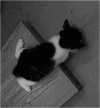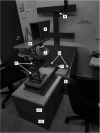My 50 Year Odyssey to Develop Behavioral Methods to Let Me See Quickly How Well Kittens See
- PMID: 40240140
- PMCID: PMC12011136
- DOI: 10.1523/ENEURO.0576-24.2025
My 50 Year Odyssey to Develop Behavioral Methods to Let Me See Quickly How Well Kittens See
Abstract
The importance of animal models to an understanding of the development and plasticity of visual functions was evident from the outset of the long experimental collaboration of David Hubel and Torsten Wiesel in the early 1960s. Their initial work on kittens had massive impact in part because of the recognition that kittens share with primates substantial similarities of visual system organization and plasticity (e.g., eye-specific lamination of the thalamus and columnar organization of the visual cortex), as well as comparable visual abilities (including stereoscopic vision). In addition the plasticity demonstrated in response to early periods of selected visual exposure provided a glimpse into the origins of amblyopia. Five decades ago my laboratory developed a method for the fast measurement of visual thresholds in kittens in order to capture the consequences for spatial vision of the rapid physiological changes that occurred in the visual cortex during both typical development and those that follow various forms of early selected visual exposure. This paper describes the further evolution of the method with an emphasis on the testing procedures that enable fast capture of spatial visual thresholds such as visual acuity on every animal and occasion. In these respects, the method emulated features of basic tests of human spatial vision as applied in clinical settings. As with clinical tests for humans, the method includes benchmarks of low vision necessary to document the profound immediate consequences of early selected visual deprivation and the speed and extent of the subsequent recovery.
Keywords: critical period; darkness; vision; visual acuity; visual deprivation.
Copyright © 2025 Mitchell.
Conflict of interest statement
The authors declare no competing financial interests.
Figures


Similar articles
-
Binocular eyelid closure promotes anatomical but not behavioral recovery from monocular deprivation.Vision Res. 2015 Sep;114:151-60. doi: 10.1016/j.visres.2014.12.012. Epub 2014 Dec 20. Vision Res. 2015. PMID: 25536470
-
The extent of visual recovery from early monocular or binocular visual deprivation in kittens.J Physiol. 1988 Jan;395:639-60. doi: 10.1113/jphysiol.1988.sp016939. J Physiol. 1988. PMID: 3411490 Free PMC article.
-
Recovery of visual functions in amblyopic animals following brief exposure to total darkness.J Physiol. 2016 Jan 1;594(1):149-67. doi: 10.1113/JP270981. Epub 2015 Nov 15. J Physiol. 2016. PMID: 26449521 Free PMC article.
-
My recollections of Hubel and Wiesel and a brief review of functional circuitry in the visual pathway.J Physiol. 2009 Jun 15;587(Pt 12):2783-90. doi: 10.1113/jphysiol.2009.169813. J Physiol. 2009. PMID: 19525563 Free PMC article. Review.
-
Normal and abnormal visual development in kittens: insights into the mechanisms that underlie visual perceptual development in humans.Can J Psychol. 1989 Jun;43(2):141-64. doi: 10.1037/h0084215. Can J Psychol. 1989. PMID: 2518607 Review.
References
-
- Berkley MA (1970) Visual discriminations in the cat. In: Animal psychophysics: the design and conduct of sensory experiments (Stebbins W, ed), pp 231–247. New York: Appleton-Century.
Publication types
MeSH terms
LinkOut - more resources
Full Text Sources
Research Materials
